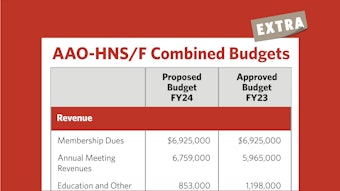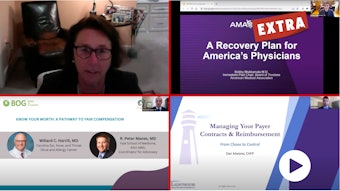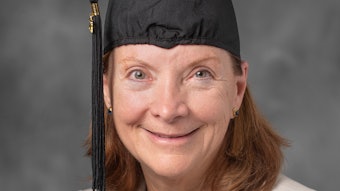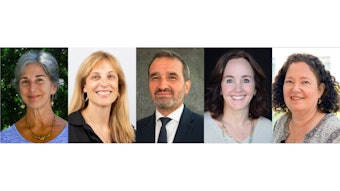Dysphagia in the Older Population, Presbyphagia, and Sarcopenic Dysphagia
An increasing older population in the United States is driving the need to have clear definitions for dysphagia in older patients, presbyphagia, and sarcopenic dysphagia.
Sara Abu-Ghanem, MD, MMedSc, Airway and Swallowing Committee Member


Geriatric syndromes represent a group of common serious conditions that are not necessarily specific to but are common with aging and have significant implications on functioning and quality of life. In 2016, the European Dysphagia Working Group suggested in a position paper that oropharyngeal dysphagia should be considered a geriatric syndrome.6
One of the challenges in reviewing the literature on swallowing and aging is the definition of an “older” population.7,8 Some authors define older adult with a cutoff as > 50-56 years,9,10 while others use > 65 or 70 years.7 From a chronological viewpoint, the medical treatment of the older population (geriatrics) starts when patients turn 65 years old. Older adults are often further divided into three life-stage subgroups: the young-old (ages > 65 and < 75 years), the old-old (ages > 75 and < 85 years), and the oldest-old (> 85 years). Previous studies have already shown that the old-old and oldest-old groups may show even greater changes in swallow function;11,12 however, the literature is sparse on this subject, and knowledge remains limited.
The effects of aging on swallowing are multifaceted, insidious, and frequently considered a natural part of aging. Older adults gradually develop characteristic changes in swallowing during aging; this phenomenon is called “presbyphagia.” Presbyphagia refers to characteristic natural changes in the swallowing process of otherwise healthy older adults.13,14 Understanding what is “normal” swallowing for older patients is critical for interpreting clinical and instrumental examinations of swallow function and avoiding overdiagnosis and overtreatment of dysphagia in the older population, which might ultimately impact the individual’s quality of life.
Unlike dysphagia, presbyphagia is generally asymptomatic and is hypothesized to be the result of changes in the anatomy and physiology of the head and neck area, muscle loss (sarcopenia), reduced functional reserve, and onset of age-related illness. Presbyphagia and unnoticed dysphagia may progress to overt dysphagia with triggers that disrupt this weak equilibrium. These include onset of an acute disease, medications, or clinical complications or disorders that worsen the patient’s clinical condition and undermine adaptive swallowing strategies and compensation.
Sarcopenic dysphagia (SD) is difficulty swallowing associated with loss of both generalized skeletal muscles (muscles of the whole body) and swallowing-related muscles.15,16 SD is a relatively new entity exclusively studied in the older population because sarcopenia and oropharyngeal dysphagia are common conditions of advanced age and have independently been considered geriatric syndromes.6
It was suggested that age-related loss in muscle mass can interact with age-related swallow changes (presbyphagia) to predispose sarcopenic older patients to develop overt dysphagia in setting of acute illness.17 SD is estimated to affect up to 32% of adults age 65 or older referred for dysphagia rehabilitation and 26% of community-dwelling older adults with dysphagia.18,19
Prevalence of dysphagia among older adults was previously reported to range from 11% to 80%. This wide range can be explained by differences in the selection and inclusion criteria of the study groups, screening or assessment tools used for swallowing function, and the cutoffs for assessing the presence of dysphagia.8,14
The three methods to assess dysphagia and swallowing function are screening tests, clinical swallowing evaluations, and instrumental exams. These methods differ in their purpose, scope, and accuracy. Screening tests for dysphagia aim to detect or predict the likelihood of swallowing dysfunction in at-risk patients who are otherwise not previously identified. Most of the screening evaluations are based on questionnaires and bedside evaluations that can be easily administered by nurses, primary care physicians, or other non-dysphagia expert personnel.
Several dysphagia assessment tools were suggested for screening in healthy older adults: the Sydney Swallowing Questionnaire (SSQ), 10-Item Eating Assessment Tool (EAT-10) questionnaire, the Standardized Swallowing Assessment, and the Volume Viscosity Swallow Test (V-VST).8 Abnormal screening test results usually do not provide information on the severity of the swallowing impairment or its etiology. Positive screening test results may necessitate referral to a dysphagia expert for a comprehensive clinical assessment of swallowing, which includes a full medical history, physical exam, and possibly an instrumental study.
The two main instrumental tests for evaluation of oropharyngeal swallowing physiology and function are Flexible Endoscopic Evaluation of Swallowing (FEES) and Videofluoroscopic Swallow Study (VFSS) also known as Modified Barium swallow Study (MBSS).
Despite increasing amount of literature and the importance of early recognition of dysphagia, there are significant weaknesses in the study design and quality of the current available studies. Future studies are needed to develop a single standardized, reliable, and validated dysphagia screening tool. Moreover, combined multidisciplinary effort, including otolaryngologists, gastroentrologists, speech language pathologists, and geriatrics, is needed to establish clear definitions for dysphagia in older patients, presbyphagia, and sarcopenic dysphagia.
References
- Vincent GK, Velkoff VA. The next four decades: the older population in the United States: 2010 to 2050. 2010. https://www.census.gov/library/publications/2010/demo/p25-1138.html
- Bhattacharyya N. The prevalence of dysphagia among adults in the United States. Otolaryngol Head Neck Surg. 2014;151(5):765-769.
- Barczi SR, Sullivan PA, Robbins JA. How should dysphagia care of older adults differ? Establishing optimal practice patterns. Semin Speech Lang. 2000;21(4):347-361.
- Lee A, Sitoh YY, Lieu PK, Phua SY, Chin JJ. Swallowing impairment and feeding dependency in the hospitalised elderly. Ann Acad Med Singapore. 1999;28(3):371-376.
- Steele CM, Greenwood C, Ens I, Robertson C, Seidman-Carlson R. Mealtime difficulties in a home for the aged: Not just dysphagia. Dysphagia. 1997;12(1):43-51.
- Baijens LWJ, Clavé P, Cras P, et al. European society for swallowing disorders - European union geriatric medicine society white paper: Oropharyngeal dysphagia as a geriatric syndrome. Clin Interv Aging. 2016;11(1):1403-1428.
- Namasivayam-MacDonald AM, Barbon CEA, Steele CM. A review of swallow timing in the elderly. Physiol Behav. 2018;184:12–26.
- Abu-Ghanem S, Chen S, Amin MR. Oropharyngeal dysphagia in the elderly: evaluation and prevalence. Curr Otorhinolaryngol Rep. 2020;8(1):34–42.
- Barikroo A, Carnaby G, Crary M. Effects of age and bolus volume on velocity of hyolaryngeal excursion in healthy adults. Dysphagia. 2015;30(5):558–64.
- Wang CM, Chen JY, Chuang CC, Tseng WC, Wong AM, Pei YC. Aging-related changes in swallowing, and in the coordination of swallowing and respiration determined by novel non-invasive measurement techniques. Geriatr Gerontol Int. 2015;15(6):736–44.
- Clark HM, Solomon NP. Age and sex differences in orofacial strength. Dysphagia. 2012;27(1):2–9.
- Vanderwegen J, Guns C, Van Nuffelen G, Elen R, De BodtM. The influence of age, sex, bulb position, visual feedback, and the order of testing on maximum anterior and posterior tongue strength and endurance in healthy belgian adults. Dysphagia. 2013;28(2):159–66.
- Feng HY, Zhang PP, Wang XW. Presbyphagia: Dysphagia in the elderly. World J Clin Cases. 2023 Apr 16;11(11):2363-2373.
- Namasivayam-MacDonald am, Riquelme LF. Presbyphagia to Dysphagia: Multiple Perspectives and Strategies for Quality Care of Older Adults. Semin Speech Lang. 2019 Jun;40(3):227-242.
- Fujishima I, Fujiu-Kurachi M, Arai H, et al. Sarcopenia and dysphagia:position paper by four professional organizations. Geriatr Gerontol Int. 2019;19(2):91–7.
- Abu-Ghanem S, Graf A, Govind J. Diagnosis of Sarcopenic Dysphagia in the Elderly: Critical Review and Future Perspectives. Dysphagia. 2022 Oct;37(5):1093-1102
- Wakabayashi H. Presbyphagia and sarcopenic dysphagia: association between aging, sarcopenia, and deglutition disorders. J Frailty Aging. 2014;3(2):97–103.
- Wakabayashi H, Takahashi R, Murakami T. The prevalence and prognosis of sarcopenic dysphagia in patients who require dysphagia rehabilitation. J Nutr Health Aging. 2019;23(1):84–8.
- Cha S, Kim WS, Kim KW, et al. Sarcopenia is an independent risk factor for dysphagia in community-dwelling older adults. Dysphagia. 2019;34(5):692–7.


















